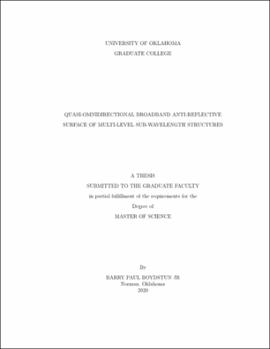| dc.contributor.advisor | Sigmarsson, Hjalti | |
| dc.contributor.author | Boydstun Jr, Barry Paul | |
| dc.date.accessioned | 2020-12-23T16:26:59Z | |
| dc.date.available | 2020-12-23T16:26:59Z | |
| dc.date.issued | 2020-12-18 | |
| dc.identifier.uri | https://hdl.handle.net/11244/326685 | |
| dc.description.abstract | The demand to remove reflections from surfaces has been a topic of interest for many decades. Accordingly, many methods and techniques have been exploited to achieve the optimum design, which is to impart no reflections at any angle of incidence. As of today, many of these optimized designs still succumb to losses from either polarization sensitivity, incident angles of dependence, narrow-banded, absorbance, and optical phenomenons such as diffraction or scattering. Moth-eye anti-reflection coatings (ARCs) of sub-wavelength structures (SWSs) have been investigated to a great extent to achieve anti-reflection characteristics. This technique is more omnidirectional, broadband, and less sensitive to the polarization of light than the older generation of ARCs using quarter-wave thin films. This thesis introduces a new procedure for designing a two-dimensional anti-reflective (AR) surface of SWSs by a method, pertaining to a series of formulas, to predetermine the bandwidth of these filters by determining the dimensions of the structure itself or vice versa, the bandwidth of the spectrum selects the profile of the structure. These formulas automatically produce the optimized AR surface concerning the broadest bandwidth and minimum reflection loss. The distinction between tapered and non-tapered SWSs is also discussed, along with each SWS's purpose, including separate methods of design for either profile. As a result, an AR surface of multi-level SWSs for a bandpass filter is calculated, simulated, fabricated, and measured. These two-dimensional structures in periodic arrays were fabricated by femtosecond laser processing in order to achieve a high aspect ratio and greater mechanical strength. The microstructure has a 175 um pitch and 188 um height giving an aspect ratio of 1.07. The design guideline's calculations agree well with the simulated results for tapered and non-tapered structures. The impact of this work is a simpler and quicker method for developing AR surfaces using subwavelength structures. | en_US |
| dc.language | en_US | en_US |
| dc.subject | Moth-Eye Anti-Reflective Coating | en_US |
| dc.subject | Multi-Level Sub-Wavelength Structure Surface | en_US |
| dc.subject | Quasi-Omnidirectional Broadband Bandpass Filter | en_US |
| dc.subject | Engineering, Electronics and Electrical. | en_US |
| dc.title | Quasi-Omnidirectional Broadband Anti-Reflective Surface of Multi-Level Sub-Wavelength Structures | en_US |
| dc.contributor.committeeMember | McDaniel, Jay | |
| dc.contributor.committeeMember | Bulcha, Berhanu | |
| dc.date.manuscript | 2020-12-18 | |
| dc.thesis.degree | Master of Science | en_US |
| ou.group | Gallogly College of Engineering::School of Electrical and Computer Engineering | en_US |
| shareok.orcid | https://orcid.org/0000-0001-9308-9523 | en_US |
